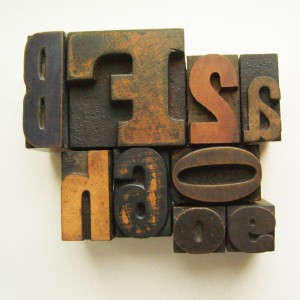Who doesn’t love letterpress? There is something so attractive about it – maybe the “intricate simplicity” of the process? Ive rarely come across a bad design – in fact, the typography is usually inspirational. I had an Agency client once that we sold on the idea of letterpress materials on HANDMADE paper. Those are the moments when it’s just awesome to be a Buyer and create the situation where a huge global corporation is supporting local artists and businesses! Oh, and all the letterpress and paper samples are pretty awesome too. Rock On Letterpress, Rock on!
The Letterpress Thrives in an iPad Age
On a March evening in Brooklyn, Donatella Madrigal is standing at a Vandercook Universal press, wiping her ink-stained hands on a denim apron. She has just run off several hundred greeting cards, which she’ll sell online and in neighborhood gift shops for up to $5 apiece. By day, the Madrid-born 27-year-old is a graphic artist who designs ads for clients such as Bobbi Brown Professional Cosmetics, working mostly on a computer. In the evenings, she goes analog, printing cards at The Arm Letterpress, a former garage filled with vintage printing presses rented out by the hour to artisans.
 Using hand-set type or plates of her own design, Madrigal places paper stock on the printer bed. She lifts a heavy crank that rolls her card stock across the inked plate with a satisfying thunk. “It’s an excuse to get down and dirty and to get away from the computer, and I’m always learning from the paper,” Madrigal says as she runs her hand across the deep grooves that the image carves into sheets of all-cotton card stock.
Using hand-set type or plates of her own design, Madrigal places paper stock on the printer bed. She lifts a heavy crank that rolls her card stock across the inked plate with a satisfying thunk. “It’s an excuse to get down and dirty and to get away from the computer, and I’m always learning from the paper,” Madrigal says as she runs her hand across the deep grooves that the image carves into sheets of all-cotton card stock.
In the past decade, letterpress printers have grown into a thriving community. Many of the most devoted members are graphic designers who, like Madrigal, are seeking an alternative to their digital day jobs. An online group called Ladies of Letterpress, “dedicated to the proposition that a woman’s place is in the print shop,” has nearly 1,500 members (including 50 men) and an annual meeting that draws more than 100 people for a weekend of workshops and schmoozing. “It’s almost like artisanal breadmaking,” says Sarah Schwartz, editor of Stationery Trends magazine, a trade publication. “People are returning to things done by hand, and it’s a very tactile art form.”
The market for letterpress items has resisted the downturn in luxury goods that followed the 2008 financial crisis. Kate’s Paperie, an upscale Manhattan stationer, says letterpress products jumped to 44 percent of sales last year from 33 percent in 2010. Etsy, the website that hosts online stores for handmade goods, listed over 22,000 letterpress items in early April, more than triple the number a year earlier. “To spend $4 on a card to send to my best friend who’s just had a baby is not a big splurge,” Schwartz says.
Traditional letterpress printers eschewed the deep impressions in the paper that Madrigal enjoys, known in printing lingo as “punch.” They preferred a smooth finish called the “kiss” that resembles the product of a laser printer. “In the old days, type would wear and you had to work carefully to make sure it all hit the paper at the same level,” says Mike O’Connor, founder of the Amalgamated Printers’ Association, a hobbyists’ guild. “You were considered a craftsman if there was no punch at all. … Now it’s the effect you want.”
Continues at: The Letterpress Thrives in an iPad Age – Businessweek.











